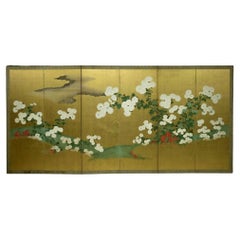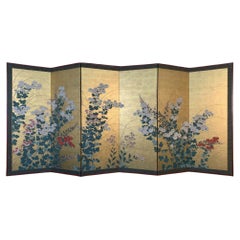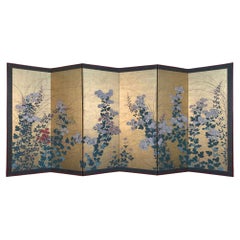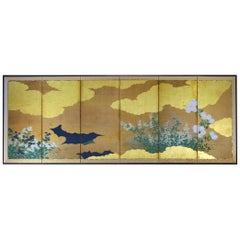Rimpa School Furniture
to
3
1
2
3
2
2
2
2
3
3
3
3
3
3
3
7,546
3,967
2,548
2,244
Creator: Rimpa School
Late Edo Period Rinpa School Chrysanthemum Blossom Screen
By Rimpa School
Located in Fukuoka, JP
Late Edo Period Rinpa School Chrysanthemum Blossom Screen
Period: late Edo, early 19th century
Size: 364 x 172 cm (143 x 67 inches)
SKU: PTA13
This exquisite late Edo period Rinpa ...
Category
18th Century Japanese Edo Antique Rimpa School Furniture
Materials
Paper
Early 19th Century Rimpa School Floral Screen
By Rimpa School
Located in Fukuoka, JP
Early 19th Century Rimpa School Floral Screen
Period: Early 19th Century
Dimensions: 367x171 cm (144.5x67.3 inches)
SKU: RJ118
This 6-panel gold-leafed screen is a splendid represe...
Category
Early 19th Century Japanese Edo Antique Rimpa School Furniture
Materials
Gold Leaf
Early 19th Century Rimpa School Floral Screen
By Rimpa School
Located in Fukuoka, JP
Early 19th Century Rimpa School Floral Screen
Period: Early 19th Century
Dimensions: 367x171 cm (144.5x67.3 inches)
SKU: RJ118/2
This 6-panel gold-leafed screen is a splendid repre...
Category
Early 19th Century Japanese Edo Antique Rimpa School Furniture
Materials
Gold Leaf
Related Items
19th Century Japanese Edo Six Panel Kano School Landscape Screen
Located in Rio Vista, CA
Late Edo period 19th century Japanese six-panel landscape screen featuring a cypress tree over a flowering hibiscus with a pair of hototogisu birds. Kano school painted with ink and ...
Category
19th Century Japanese Edo Antique Rimpa School Furniture
Materials
Silk, Wood, Paper
Japanese Edo Four Panel Screen Flowering White Chrysanthemums
Located in Rio Vista, CA
19th century extraordinary Japanese late Edo/early Meiji period four-panel byobu screen featuring flowering white chrysanthemums painted in a moriage (raised pigment) style. The pain...
Category
19th Century Japanese Edo Antique Rimpa School Furniture
Materials
Brass, Gold Leaf
19th Century Chinese Window Lattice Panel Screen
Located in New York, NY
19th Century Window Lattice Screen. Very special Lattice Screen Window Panel from Shanxi China 19th century. Wonderfully assembled sculpted pieces of Cypress wood with each face ro...
Category
Mid-19th Century Chinese Qing Antique Rimpa School Furniture
Materials
Cypress
19th Century Japanese Edo Screen Kano School Garden Terrace
Located in Rio Vista, CA
Fantastic 19th century Japanese Edo/Tokugawa period two-panel byobu screen featuring Chinese children frolicking on a garden terrace with a pavilion and large pine tree. Made in the ...
Category
19th Century Japanese Edo Antique Rimpa School Furniture
Materials
Brass, Gold Leaf
Japanese Edo Period Six Panel Screen of Chinese Scholars
Located in Rio Vista, CA
Fascinating 19th century Japanese late Edo period six pane funpon screen. Large scale depicting Chinese scholars and officials engaged in leis...
Category
19th Century Japanese Edo Antique Rimpa School Furniture
Materials
Silk, Wood, Paper
18th Century Japanese Kano School Landscape Screen
Located in Prahran, Victoria
Japanese Kano school screen with pine tree, camellias, cherry blossom and Chinese figures in the landscape, circa 18th century.
Materials: Pigmen...
Category
18th Century Japanese Antique Rimpa School Furniture
Materials
Silver Leaf
Pair of 19th Century Japanese Screens
Located in Bagshot, GB
A pair of large 19th century Japanses Screens of Japanese scenery.
The screens also come with a wooden crate which would have been built for them at a later date in order to move ...
Category
19th Century Asian Other Antique Rimpa School Furniture
Materials
Paper
19th Century Japanese Screen
Located in Gloucestershire, GB
Mid-19th Century Japanese sixfold screen with atmospheric Nanga style painting.
Black ink over gold leaf on paper, of a peaceful mountainous landscape emerging from mist. In the fore...
Category
19th Century Japanese Chinoiserie Antique Rimpa School Furniture
Materials
Gold Leaf
18th Century Japanese Rinpa Screen. White Chrysanthemums. School of Korin.
Located in Kyoto, JP
School of Ogata Korin
White Chrysanthemums
18th Century, Edo period.
A two-panel Japanese screen. Ink, color, gofun and gold leaf on paper.
Dimensions: H. 171 cm x W. 188 cm (67.5” x 74”)
On this two-panel Japanese screen we see blooming chrysanthemums, a flower which embodies the essence of autumn in Japan. Here the traditional floral theme has been simplified and stylized. The bright colors and asymmetrical composition against the delicate gold leaf create a luxurious and ornate work of art. Its background, a strikingly patinated grid of gold leaf, denies any sense of place or time and imbues everything with an ethereal glow. The leaves and stems of the plants are nothing more than pools of mottled color and ink without any outline whatsoever. These are typical Rinpa adaptations of traditional ink painting methods; tarashikomi, or diluted washes of color blended while very wet, and mokkotsu, or “bonelessness,” which creates forms without exterior outlines. The relief work of the rounded flower petals has been obtained by the moriage process (a mixture based on ground shells modeled on the surface of the paper).
On the lower right of the screen, the siganture “Hokyo Korin Jakumyo” and the “Hoshuku” seal can be read. Korin is Ogata Korin, famed for the Irises (Nezu Museum) and Red and White Plum Blossom (MOA Museum of Art) folding screens, both National Treasures. Korin worked in both Kyoto and Edo in the mid-Edo period. Korin was using the art name “Jakumyo” just after he received the Hokyo level, which was in 1701.
This particular screen was published in May of 1961 in the Japanese Sansai Fine Art Magazine*. An in depth article accompanies the photograph of the screen and and a photograph of the signature and seal. This article devotes much of its body to discussing the moriage technique, how it enlivens the chrysanthemum flowers and Korin’s specific skill in using the technique. The article goes on to discuss the most famous works of Korin, utilizing this technique, which were known at the time. Specifically a two-panel screen held in the Honolulu Museum which was discovered in the store-house of Takahashi Soan. A two-panel screen pair which the Nakano family own. A two-panel screen pair with chrysanthemums in moriage in fan designs owned by the Nomura family. Also a small folding screen featuring chrysanthemums held in the Yamato Bunkakan. The article goes on to say that this particular two-fold screen came from the Nijo family. Korin is known to have had a strong connection with the aristocratic Nijo family. The article explains that Korin received a lot of favors from the Nijo family and that this screen would have been gifted to them.
Since that time the Honolulu screen has been amended to ‘attributed to Ogata Korin’ and I do not know further details of the other 3 screens. Other Chrysanthemum screens...
Category
18th Century Japanese Edo Antique Rimpa School Furniture
Materials
Gold Leaf
H 67.5 in W 74 in D 0.75 in
19th Century Japanese Screen, Deer in Spring, Maruyama Shijo School
Located in Kyoto, JP
A six-panel Japanese folding screen from the leading Maruyama-Shijo artist Okamoto Toyohiko (1773-1845). Simply featuring three deer and a few sprigs of foliage on a sumptuous gold-leaf background this work emphasizes naturalistic expression and a masterful use of negative space. Reduced to its most basic elements, the blank spaces inspire imagination and evoke the smells, sounds and even the weather of the scene. Whilst deer are traditionally depicted in association with autumn, here the green growth on the tops of the foliage indicates the season of spring. The work references Maruyama Okyo’s two-panel deer screen...
Category
Early 19th Century Japanese Edo Antique Rimpa School Furniture
Materials
Gold Leaf
18th Century Japanese Screen Pair. Plum & Young Pines. Kano School.
Located in Kyoto, JP
Dimensions (Each screen): H. 176 cm x W. 378 cm (69’’ x 149’’)
This pair of Japanese folding screens depict blossoming plum trees amongst young pines. They are designed to capture t...
Category
Late 18th Century Japanese Edo Antique Rimpa School Furniture
Materials
Gold Leaf
Japanese Edo Four Panel Screen Kano School Filial Piety
Located in Rio Vista, CA
Early 19th century late Edo period Japanese four-panel screen depicting examples from the 24 paragons of filial piety. Painted in the Kano School style featuring figures in colorful,...
Category
19th Century Japanese Edo Antique Rimpa School Furniture
Materials
Brass, Gold Leaf
Previously Available Items
Edo Period 19th Century Japanese Folding Screen Six Panels Flowers on Gold Leaf
By Rimpa School
Located in Brescia, IT
Clouds of gold, water and many colorful flowers: Japanese six-panel folding screen by Rimpa School. Hand painted with rice mineral pigments and inks on rice paper and gold leaf.
Category
Early 19th Century Japanese Edo Antique Rimpa School Furniture
Materials
Gold Leaf
H 42.92 in W 113 in D 0.79 in
Rimpa School furniture for sale on 1stDibs.
Rimpa School furniture are available for sale on 1stDibs. If you’re looking for additional options, many customers also consider furniture by Utagawa Hiroshige (Ando Hiroshige), and Arita.





